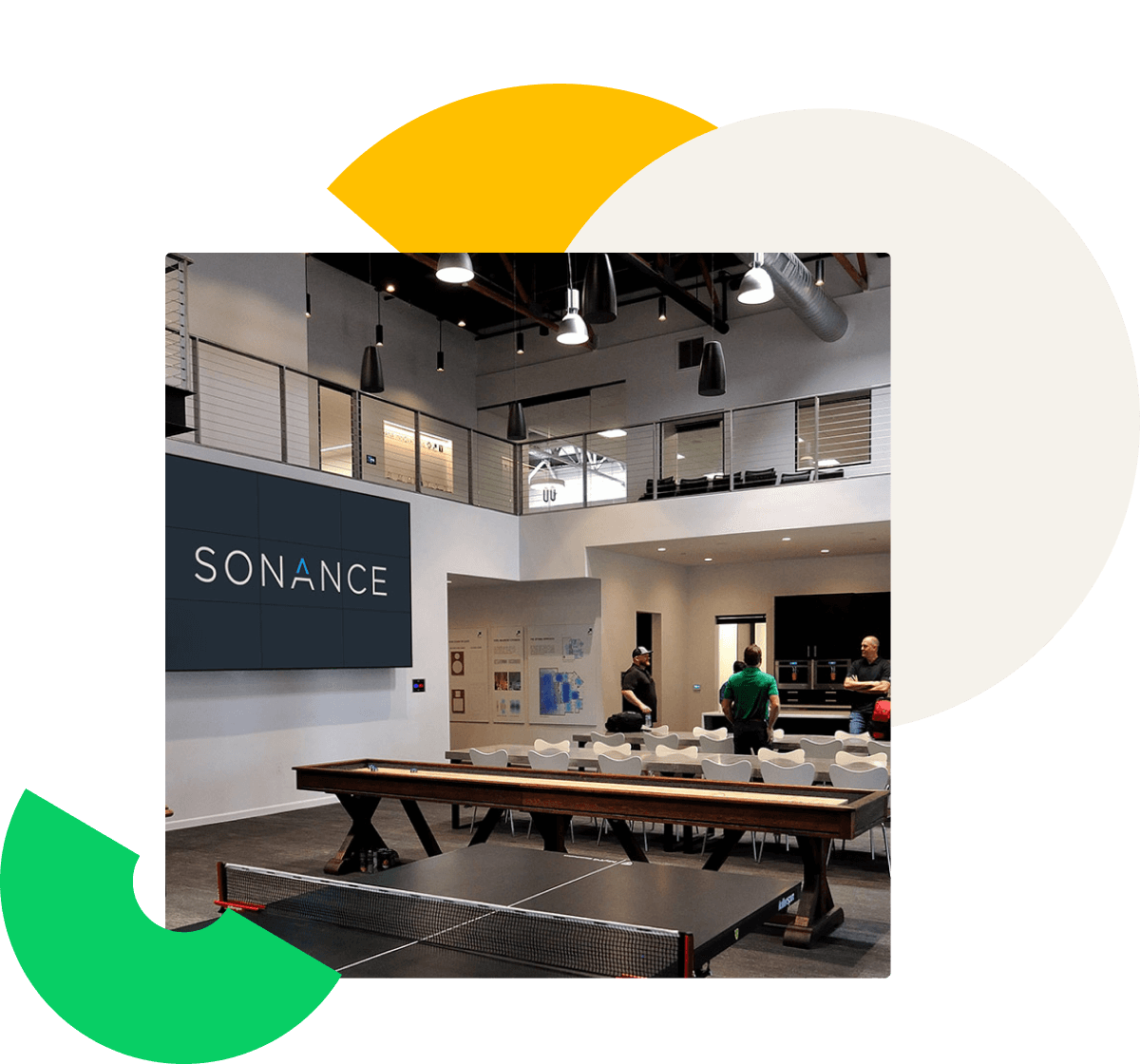Wrike Is a “Game-Changer” That Brings the Sonance Product Lifecycle Management Process to Life

Wrike Is a “Game-Changer” That Brings the Sonance Product Lifecycle Management Process to Life

Sonance is one of the most recognized and highly awarded architectural speaker and outdoor audio manufacturers in the world. Creator of the in-wall speaker, Sonance offers ceiling and outdoor speakers installed in residential and commercial spaces across the United States, as well as the TRUFIG product line, which allows any technology to be installed flush with the surface of a wall or ceiling. Sonance also offers the iPort brand, which transforms tablets into dedicated-use devices that can control automation systems in a home or act as a kiosk, mobile sign, or conference room controller for a business.
decrease in delays after product announcements
As Sonance and its product lines grew and expanded, the company struggled with its product lifecycle management process. The process had been developed and refined
over time but wasn’t producing the results it used to. The company still operated as a lean startup, but now that it had grown and had teams in both California and China,
it was difficult to keep work on track. Roadblocks popped up throughout the process, and as more people became involved, meeting deadlines became more challenging.
On average, Sonance product development projects consist of 400 tasks. Sonance used multiple methods and tools to manage the workflow, including Microsoft Excel, email, meetings, presentations, and project management solutions, but the team struggled to find the right solution. Communication and collaboration across time zones and continents was also difficult. “We needed to coordinate complex phasing of developments and launches, and it was critical to have a built-in system to manage approvals with multiple contributors — and we didn’t have those abilities,” said Derick Dahl, Director of Product Management. “Delays became the rule instead of the exception.”
Because Sonance was simultaneously juggling multiple projects and launches, errors occurred, launch elements were overlooked, and sequencing of approvals was unclear.
This led to engineering delays and last-minute firmware updates that threatened delivery, putting Sonance’s long-standing reputation at risk.
Perhaps the most critical issue Sonance needed to address was resource management. With 18 product categories and more being developed on a regular basis, employees
worked across business lines, products, and teams for engineering, development, and launch projects. Each employee could be assigned to up to 12 projects at a time. There wasn’t much visibility into individual workloads, which was leading to overcommitment and burnout. Management knew that constantly switching between multiple projects and teams was draining employee energy and morale, and grew concerned about an exodus of talent.
As Director of Product Management, Dahl is responsible for managing the product development process across Sonance’s business lines, from design to delivery, coordinating efforts across engineering, operations, product, and marketing. Dahl led the search for a solution that could improve the lifecycle management process and help Sonance:
Additionally, Sonance wanted a cloud-based solution that supported collaboration between offices in the U.S. and China, could handle complex interlinking between
dependencies and milestones, and offered the ability to view projects from a macro-level perspective and drill down into details.
Sonance tried multiple tools, including Microsoft Excel, Smartsheet, Teamwork, and Redbooth. While some handled a few requirements, only Wrike met all of their objectives.
“Just using Wrike right out of the box resolved a bunch of the problems we were having and helped avoid delays,” said Dahl.
Wrike's resource management capabilities helped bring the product life cycle management process and methodology that’s part of the DNA of our company to life, and it’s just incredible.
Critical to the transformation was establishing Wrike as Sonance’s single source of truth, which enabled the development of a product management framework. The team started by templatizing the product life cycle management process into 10 key stages. From there, they identified the key tasks in each stage. That number varies from as few as five tasks to as many as 120, depending on complexity, project phase, and the teams involved. Sonance then created an ultimate master template that captures everything a project manager needs to consider when beginning a development project. Establishing this infrastructure and master template provides a consistent and straightforward framework to think methodically about all required project elements during initial planning. That, in turn, significantly reduces the amount of time required to start a project, from approximately 10 hours to two hours.
Next, Sonance used Wrike to design individual product workflows and custom workflow statuses. Along with the master template, that gave everyone a clear view of assigned tasks, deadlines, milestones, and hand-offs between departments. Wrike enables the team to visualize the exact sequence of events that could delay launches and reduce bottlenecks and delays before they even occur.
“Wrike helped bring to life the product life cycle management process and methodology that’s part of the DNA of our company, and it’s just incredible,” said Dahl. “We set the expectations, and we met the expectations, and that was awesome.”
Before Wrike, the review and approval process was inefficient and ineffective with dispersed teams and multiple stakeholders working in email and attachments. Having Wrike as the single source of truth helped centralize conversations and assets, and Wrike's proofing functionality streamlined the review and approval process. Project managers can assign approvers and then gather all comments, feedback, and discussion in one place. Now version control is simpler, gaining consensus and approval is easier, and they can move to production more quickly.
Engineering change orders (ECOs) are a good example. They need to be reviewed and approved by multiple departments, which used to involve PDFs, email chains, and coordination of sequential approvals. “Managing ECOs using Wrike’s collaboration features has been so much easier,” said Dahl. “The attachment is within a task, review and approval is within the task, the next person knows when it’s their turn, and the engineering manager knows immediately when to send it to the factory. It’s been a monumental change for Sonance.” ECOs now take only a few days, down from an average of three weeks before Wrike.
Prior to Wrike, Sonance used a combination of tools for reporting, but each had issues and none were powerful enough to deliver the required reporting capabilities. With Wrike, Dahl can create real-time visual summaries of the next 24 months of all development projects using the Gantt charts feature. The information is now useful, understandable, and actionable. Wrike allows Sonance to access real-time reporting at the brand level and track each active and development project by milestones.
Wrike is flexible enough to allow individual users to choose their preferred workflow view, including tables, lists, and more, increasing employee utilization. Sonance employees have found the Gantt chart capabilities especially useful, and personalized dashboards are valuable for employees at all levels. Dahl adds, “A tool is only as useful as you make it by using it, so we are really champions of Wrike to encourage our employees to use it. Once they see the benefits, they are all in.”
Thanks to Wrike, Sonance achieved its initial objectives, including better visibility. They decided to dive even deeper into the details to better understand the number of projects employees were working on at any given time so they could reduce employee stress and burnout. Sonance again turned to Wrike and piloted the resource management features within the marketing group.
Wrike was the first solution that enabled the company to balance workload — reassigning a project, adjusting the deadline, or just removing it from someone’s plate. “Wrike's resource management functionality helped control the otherwise overwhelming nature of our marketing team’s work by allowing us to identify and correct overtaxed employee workloads, reducing the average number of active projects per employee from 12 down to three,” said Dahl.
“By using Wrike to redistribute high-priority projects more evenly across the team and schedule out other non-critical projects, the team gained more control over the work, tensions subsided, the quality of output increased, and, ultimately, output itself increased,” said Dahl. “The marketing team was able to move from being reactive to proactive in work assignments, become a more effective and efficient team, and gain more insight into the business. Bottom line: Employees were happier after seeing changes being made. We saw an increase in employee engagement, excitement for what we were doing, and a greater sense of purpose from knowing how each person fit into the company.”
In return, the marketing team was able to help support the sales side of the business in a more impactful way. Product launches, promotional projects, outbound marketing communications, and campaigns improved significantly, which ultimately helped the company’s bottom line.


“Around the office, we say Wrike is our friend. It’s something people rely on because they know how much it helps them, and that means a lot,” says Dahl. Wrike has become the backbone of the program management department, and implementing Wrike has greatly benefitted Sonance. The communication around product launches has been more timely and tied to engineering progress. And delays following product announcements have decreased by 80%. Wrike helps Sonance deliver what they say they will, when they say they will.
Additionally, Wrike has alleviated project stackup in marketing and changed the atmosphere of that department. Employees are less stressed and more productive and now have the bandwidth to be creative.
“Wrike has been a game-changer for Sonance,” said Dahl. Wrike provides the collaboration, resource management, and reporting capabilities Sonance requires in one single source of truth. It’s the solution Sonance needs to elevate its product life cycle management process and improve the reputation the company has built over more than 35 years in business.
Find out how Wrike can help your business


